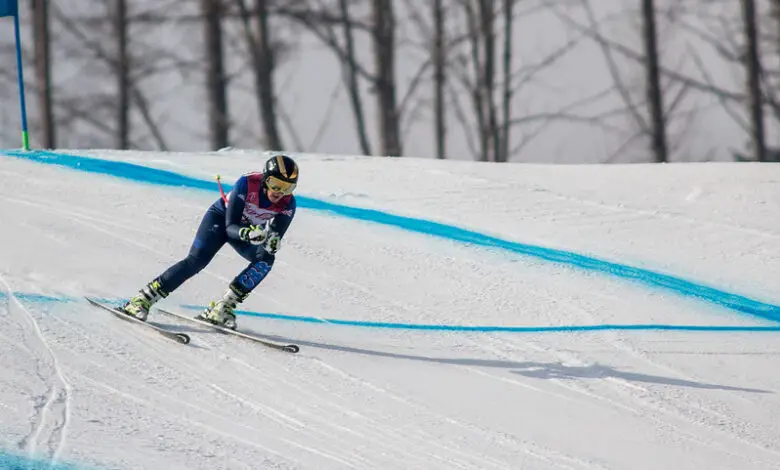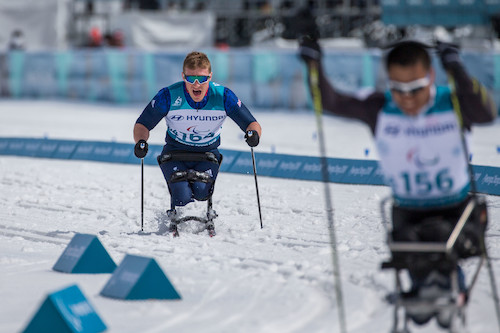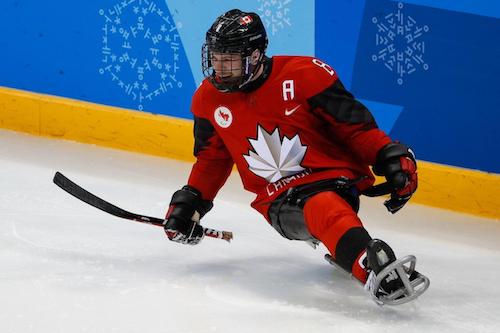
5 spectacular winter para-sports athletes will compete in at the Beijing 2022 Paralympic Winter Games
The Beijing 2022 Paralympic Winter Games has officially opened and the sporting action will soon begin. Over the next 9 days, we’ll get to watch more than 600 athletes compete in 5 spectacular winter para-sports – Alpine skiing, Nordic skiing, snowboarding, ice hockey and wheelchair curling – all in the hope of securing a medal and a spot on the podium.
Here at Disability Horizons, we guide you through everything you need to know about the 5 winter para-sports and what the impairment classifications mean.
Para Alpine skiing

Para Alpine skiing consists of five disciplines – downhill, slalom, giant slalom, super giant slalom (super-G) and super combined. Athletes combine speed and agility while racing down slopes at speeds of around 100km/h.
The sport accommodates male and female athletes with a physical impairment such as spinal injury, cerebral palsy, amputation and blindness/visual impairment.
Results are factored to take each athletes’ degree of impairment into account when calculating a time. While there are different factors for the different disciplines in each of the three-sport classes, the same factors are used for men and women.
Athletes and spectators see the factored time after each run. In all events, the winning competitor is the one who, without missing any gates, records the fastest factored time over the course.
Para Alpine skiing disciplines
- Downhill: Athletes ski down a long, steep course that varies from 450m to 800m. Competitors are required to pass through a series of red gates that are used as checkpoints. If an athlete misses a gate they are disqualified.
- Super-G: Competitors are held on a slope with a vertical drop variation of 400m to 600m, with the course marked with a minimum of 30 alternating blue and red gates, positioned to enforce changes of direction.
- Giant Slalom: A technical event in which gates are closer than those in the speed events and the vertical drop varies from 300m to 400m. The competition is contested over two rounds using the same slope but with different courses. Times from the two runs are added together to determine the final order based on ascending total time.
- Slalom: Athletes compete in the same way as giant slalom with a vertical drop that can be between 140m to 220m and the number of gates on the course varies. It requires considerable agility and dexterity since the slopes are very steep, with thick snow, often artificially iced, to avoid any premature deterioration of the surface.
- Super Combined: An event that incorporates elements from other events but is itself a standalone event. Contested on a single day, it comprises one run of either downhill or super-G and one run of either giant slalom or slalom.
Para Alpine skiing classifications
In Para Alpine skiing, there are 15 classifications in total divided into three categories:
- Sport classes LW 1-9: Standing skiers: These athletes compete in standing skiing and the sport is divided into nine classifications, which include impairments/amputations in both legs, one leg, both arms, one arm and a combination of arms and legs.
- Sport Classes LW 10-12: Sit-skiers: These athletes compete in sit skiing and all have leg impairments. The sport is divided into three classifications, which include no or minimal trunk stability, very limited control in their lower trunk and hips and slightly decreased trunk function and leg impairments.
- Sport Classes B1-3: Skiers with visual impairment: These athletes are blind or visually impaired and use a guide when skiing. The sport is divided into three classifications, which include blind or has very low visual acuity, moderate visual impairment and mild visual impairment.
Para Nordic skiing

Para Nordic skiing consists of two disciplines, cross-country skiing and biathlon. Both have medal events for men and women and people with a physical or visual impairment can compete.
Para Nordic disciplines
- Cross country skiing: Cross country skiers can compete in individual or team, classical or freestyle events ranging from 2.5km to 20km in distance.
- Biathlon: Biathlon combines cross-country skiing and target shooting. Athletes ski three 2.5km legs (7.5km in total) and fire at five targets (located 10m from the shooter) between each leg using air guns that are mounted on stands.
Para Nordic skiing classifications
In cross country skiing, visually impaired skiers compete with a guide, while athletes with a physical impairment compete using either a sit-ski or standing using one or two skis and/or poles.
In biathlon, athletes compete in one of three categories – sitting, standing and visually impaired. In the shooting, visually impaired athletes
- Sport classes LW 2-9: Standing skiers: These athletes compete in standing skiing and the sport is divided into seven classifications, which include impairments/amputations in both legs, one leg, both arms, one arm and a combination of arms and legs.
- Sport Classes LW 10-12: Sit-skiers: These athletes compete in sit skiing and all have leg impairments. The sport is divided into five classifications, which include no or minimal trunk stability, very limited control in their lower trunk and hips and slightly decreased trunk function and leg impairments.
- Sport Classes B1-3: Skiers with visual impairment: These athletes are blind or visually impaired and use a guide when skiing. The sport is divided into three classifications, which include blind or has very low visual acuity (B1), moderate visual impairment (B2) and mild visual impairment (B3).
For B1 skiers a guide is obligatory and B2 and B3 skiers may choose to ski with a guide. The guide skis immediately ahead of the athlete and verbally inform the athlete of course specifics such as corners, inclines, and declines.
In Biathlon, athletes with visual impairment shoot at the target by following sound signals.
Para snowboarding

In Para snowboarding, the sport includes male and female athletes with physical impairments such as spinal injury, cerebral palsy and amputation.
Athletes compete in two events at the Winter Paralympics – snowboard cross and banked slalom.
Para snowboarding disciplines
Snowboard cross
During qualification, each athlete completes three runs down the course with their best run determining the final order based on ascending time. There is only one rider on the course at a time during qualification.
Finals comprise 16 men and eight women, with two competitors per heat or such other numbers as determined by the jury. The finalists race against each other to determine the final rankings.
The ideal snowboard cross may allow the construction of any features excluding -gap jumps, corner jumps, spines and double spines, cutting banks, giant slalom turns and negative banks.
Banked slalom
Each athlete completes three runs down the course with their best run determining the final order, based on the ascending time. There is only one rider on the course at a time.
The course may be a medium pitched slope. It may be naturally varying terrain, with plenty of bumps and dips, and preferably a U-shape/natural valley.
Para snowboarding classifications
Athletes compete in three categories based on their functional ability – SB-LL1 and SB-LL2 for athletes with lower-limb impairments and SB-UL for athletes with upper limb impairment.
Para ice hockey

Para ice hockey is a version of Olympic ice hockey for athletes with a lower limb impairment.
Many of the rules and regulations of the sport are the same as Olympic ice hockey but the main difference is in the technical equipment used.
Athletes use specially designed sledges fitted with two blades to propel themselves across the ice and have two playing sticks, which have a double function – they are used for pushing, much like a ski-pole in cross country skiing, and to control and shoot the puck.
The game comprises three 15 minute periods. Six players are allowed on the ice at any time and a total of 15 players make up a team.
Para ice hockey classifications
Para ice hockey only has one classification for people with a lower limb impairment, which prevents them from competing in able-bodied ice hockey. Therefore, players may have a leg amputation, paralysis or muscle weakness in their legs.
Wheelchair curling

Wheelchair curling is a tactile team sport, in which players slide stones with handles across the ice, aiming for them to come to a stop on a target, called the house, which is marked by four concentric circles.
A team declares its delivery rotation, and the skip and vice-skip player’s positions, before the start of a game and maintains that rotation and those positions throughout that game.
The Lead player delivers the first stone and the play continues with each athlete delivering two stones, alternating with the opposing team.
Two teams take turns to deliver stones down the ice attempting to get closer to the centre of the target than their opponents. The team that places the most stones closest to the centre of the house wins the point.
The stones made for curling are made of smooth granite and must conform to very precise parameters – a circumference of 91.44cm and a height of not less than 11.43cm. The weight including the handle must not exceed 19.96kgs.
Delivery of the stone may be undertaken by the conventional arm/hand release or by the use of an extender cue. There is only one major modification for wheelchair curling – no sweeping is permitted, unlike Olympic curling.
Each game is played over eight ends with an extra end played should the teams be tied.
Each team must include male and female players and a female athlete must be on the ice at all times. The team is made up of four players and a qualified alternate may be brought into play at the beginning of an end to substitute one of their teammates.
Wheelchair curling classifications
The sport is open to male and female athletes who have a physical impairment in the lower half of their body, including spinal cord injuries, cerebral palsy, multiple sclerosis and double-leg amputation. Athletes usually require a wheelchair for daily mobility.
To find out about some of the athletes competing in Beijing, check out our article 10 Paralympians to watch out for at the Beijing 2022 Paralympic Winter Games.
All Winter Paralympic coverage will be broadcast on Channel 4, which will include its first all-star disability presenting team.
Throughout the Paralympic Winter Games, people from the DH team and community will be sharing all the latest news, results, facts and gossip from Beijing, so please be sure to follow us on Twitter @DHorizons.
By Disability Horizons
More on Disability Horizons…